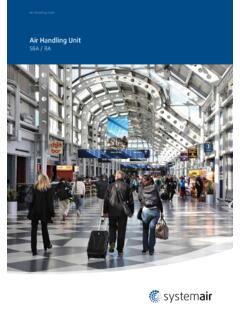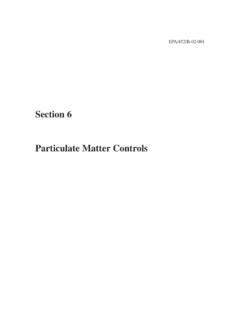Transcription of Air Pollution Cocntrol Technology Fact Sheet
1 EPA-452/F-03-023 Air Pollution Cocntrol Technology Fact SheetEPA-CICA Fact SheetFabric FilterHEPA and ULPA Type1 Name of Technology : Paper/Nonwoven filter - high efficiency Particle Air (HEPA) filter - Ultra Low Penetration Air (ULPA) filter (also referred to as Extended Media)Type of Technology :Control Device - Capture/DisposalApplicable Pollutants:Submicron Particulate Matter (PM) greater than or equal to micrometer ( m)in aerodynamic diameter, and PM greater than or equal to m in aerodynamic diameter that is chemically,biologically, or radioactively toxic; hazardous air pollutants (HAPs) that are in particulate form, such as mostmetals (mercury is the notable exception, as a significant portion of emissions are in the form of elementalvapor).Achievable Emission Limits/Reductions: HEPA and ULPA filters are classified by their minimum collection efficiency . Many international standards andclasses currently exist for high efficiency filters (Osborn, 1989).
2 In general, HEPA and ULPA filters are definedas having the following minimum efficiency rating (Heumann, 1997):HEPA: efficiency for the removal of m diameter or larger PM,ULPA: efficiency for the removal of m diameter or larger extended media filters are capable of much higher efficiencies. Commercially available filters cancontrol PM with m diameter at efficiencies of +% and PM with m diameter at efficiencies +% (Gaddish, 1989; Osborn, 1989). Several factors determine HEPA and ULPA filter collectionefficiency. These include gas filtration, velocity, particle characteristics, and filter media characteristics. Ingeneral, the collection efficiency increases with increasing filtration velocity and particle size. In addition, thecollection efficiency increases as the dust cake thickness and density increases on the filter (EPA, 1998a).Testing of the collection efficiency for HEPA and ULPA filters is performed under clean filter conditions.
3 Thisis in contrast to continuously cleaned-type filters, such as baghouses, which are tested after reaching asteady-state pressure drop. Cleaned-type filters have nearly constant effluent particle concentration, whereasHEPA and ULPA filters have overall efficiencies which vary with particulate loading. (Heumann, 1997)The efficiency of each filter is tested by the manufacturer before shipping. For nuclear applications, additionaltests are required by the Department of Energy (DOE) and by the owner/operator after installation (Burchstedet al, 1979). There are two separate tests for HEPA and ULPA filter collection efficiencies. HEPA efficiencyis rated using a thermal dioctyl phthalate (DOP) test. The test dust for HEPA filters is mono-sized, mdiameter, DOP particles, generated by vaporization and condensation. Alternative aerosols can also be usedas specified or required for given applications. A photometer measures the particle penetration of the HEPA filter by sensing the scattering of light.
4 ULPA efficiency is tested using a particle counter upstream anddownstream of the filter . An atomizer injects a solution of DOP, alcohol, and mineral oil in hexane to generateparticles ranging from of to m in diameter (Heumann, 1997).Applicable Source Type: PointEPA-CICA Fact SheetFabric FilterHEPA and ULPA Type2 Typical Industrial Applications:HEPA and ULPA filters are best applied in situations where high collection efficiency of submicron PM isrequired, where toxic and/or hazardous PM cannot be cleaned from the filter , or where the PM is difficult toclean from the filter . HEPA and ULPA filters are typically utilized for applications involving chemical, biological,and radioactive PM. HEPA and ULPA filters are installed as the final component in a PM collection system,downstream from other PM collection devices such as electrostatic precipitators or baghouses. (Heumann,1997)Common industrial applications of HEPA and ULPA filters are hospital, low-level nuclear, and mixed wasteincinerators and nuclear air ventilation and safety systems.
5 In addition, the filters are used in a number ofcommercial applications and manufacturing processes such as clean rooms, laboratories, food processing,and the manufacture of pharmaceuticals and microelectronics (Osborn, 1989). The filters can be utilized inany application where dust is generated and can be collected and ducted to a central location. Emission Stream Flow: HEPA and ULPA filters are currently limited to low capacity air flow filter packs are factory-built, off the shelf units. They may handle from less up to standard cubic meters per second (sm3/sec) (( hundreds to 2,000 standardcubic feet per minute (scfm)) (AAF, 2000; Vokes,1999). HEPA filter systems designed fornuclear applications require higher capacities. For these applications, filter banks, ormodules are ducted together in parallel to increase air flow capacity (EPA, 1991).Commercially available modular systems can accommodate air flow rates in the range of 5to 12 sm3/sec (5,000 to 40,000 scfm) (AAF, 2000; Vokes, 1999).)
6 Air flow capacity is a function of the resistance, or pressure drop across the filter and particleloading. As the dust cake forms on the filter , the resistance increases, therefore, the air flowrate decreases. Since the filter is not cleaned, the air flow rate continues to decrease as thesystem operates. After the pressure drop across the filter reaches a point that preventsadequate air flow, the filter must be replaced and disposed. For these reasons, HEPA andULPA filters are used in applications that have low air flow rates or have low concentrationsof PM (Heumann 1997). : Temperatures are limited by the type of filter media and sealant used in thefilter packs. Standard cartridges can accommodate gas temperatures up to about 93 C(200 F). With the appropriate filter media and sealant material, commercial HEPA filters canaccept temperatures of up to 200 C (400 F). HEPA filters with ceramic or glass packingmechanical seals can accept temperatures up to 537 C (1000 F).
7 (EPA, 1991) Spray coolers or dilution air can be used to lower the temperature of the pollutant prevents the temperature limits of the filter from being exceeded (EPA, 1998b). Lowering the temperature, however, increases the humidity of the pollutant stream. HEPAand ULPA filters can tolerate some humidity. Humidity higher than 95%, however, can causethe filter media to plug, resulting in failure (EPA, 1991). Therefore, the minimumtemperature of the pollutant stream must remain above the dew point of any condensablein the stream. The filter and associated ductwork should be insulated and possibly heatedif condensation may occur (EPA, 1998b). Loading: Typical pollutant loading ranges from 1 to 30 grams per cubic meter(g/m3) ( to 13 grains per cubic foot (gr/ft3)) ( Novick, et al, 1992). Dust holding capacitycompares the weight gain of the filter to the rise in pressure drop during a specific period ofEPA-CICA Fact SheetFabric FilterHEPA and ULPA Type3time (air flow volume).
8 Typical inlet dust holding capacity range from 500-1000 g/1000 scfm(Gadish, 1989). As discussed above, the pressure drop across the filter is a function ofpollutant loading. HEPA and ULPA filters are best used in applications that have lowconcentrations of PM, or prohibit cleaning of the filter (Heumann, 1997). Considerations: Moisture and corrosives content are the major gas streamcharacteristics requiring design consideration. As discussed previously, humidity up to 95%is acceptable with the proper filter media, coatings, and filter construction. Filters areavailable which can accommodate corrosive gas streams with concentrations up to severalpercent. These filters are constructed of special materials and are generally more expensive.(EPA, 1991)HEPA and ULPA filters are monitored for pressure drop across the filter media. Once thepressure drop becomes unacceptable, the filter must be replaced.
9 The typical pressure dropfor a clean filter is 25 millimeters (mm) of water column (1 inches (in.) of water column). Anincrease of the pressure drop in the range of 51 to 102 mm of water column (2 to 4 in. ofwater column) indicates the end of the service life of the filter (EPA, 1991, Burchsted et al,1979). Newer filters are available which have clean filter pressure drops in the range of 6 to13 mm of water column ( to in. of water column) (Burchsted et al, 1979).HEPA and ULPA filters are typically operated under pressure of approximately 203 mm ofwater column (8 in. of water column) high operating pressures may rupture the filter . HEPA filters utilized in the nuclear industry have seismic requirements in addition to theperformance characteristics discussed above. (EPA, 1991)Emission Stream Pretreatment Requirements:HEPA and ULPA filters require pre-filtering to remove large PM or for dust concentrations greater gramsper centimeter squared (g/cm2) ( pounds per feet squared (lbs/ft2)).
10 Pre-filtering may be performed inseveral stages. Mechanical collectors, such as cyclones or venturi scrubbers may be required to reduce largediameter PM. Standard baghouse or cartridge filters are required to filter out PM greater than m indiameter. (EPA, 1991)In high temperature applications, the cost of high temperature-resistant filter designs must be weighed againstthe cost of cooling the inlet temperature with spray coolers or dilution air (EPA, 1998b). Cost Information:The capital cost for a HEPA filter system is given below. The cost estimate assumes a factory-built, off theshelf modular design under typical operating conditions. The filter system is for a nuclear application andincludes one test section and a pair of pressure sensors. Auxiliary equipment, such as fans and ductwork,is not included. The estimate is based on a manufacturer quote for only the purchased equipment cost in 1999 dollars (AAF,2000).













